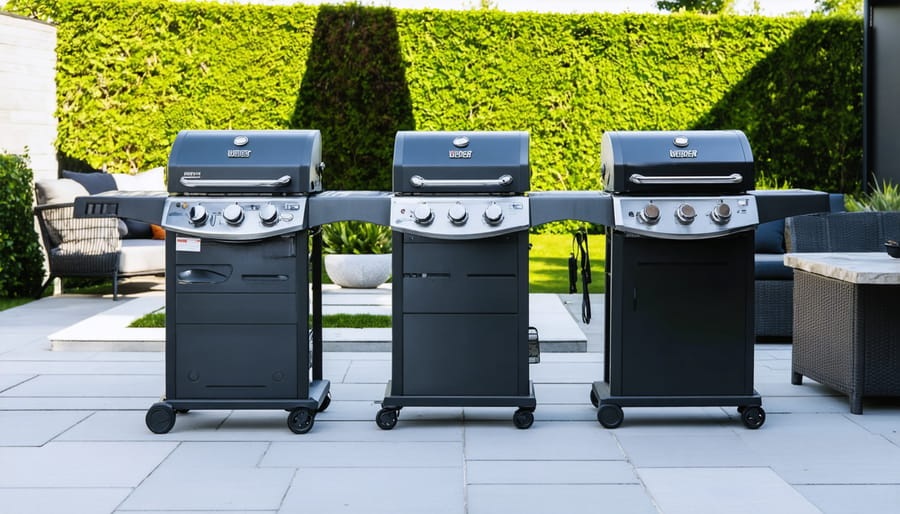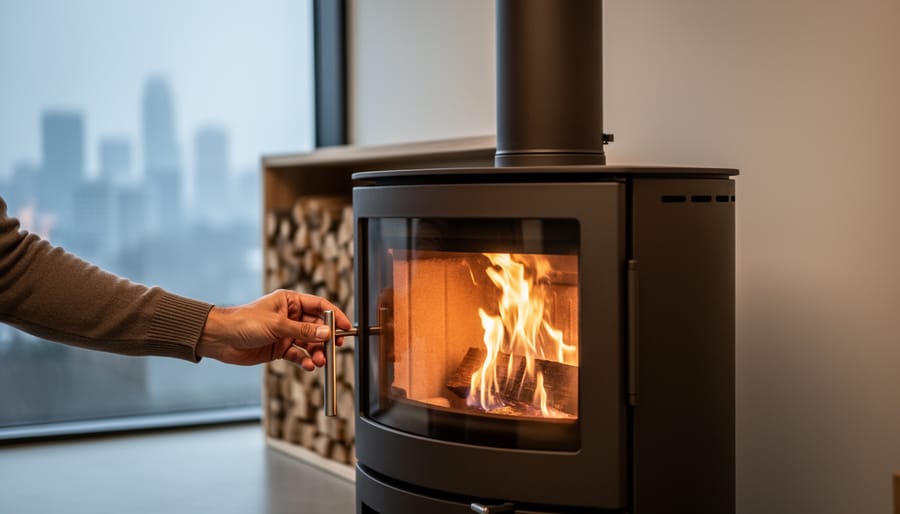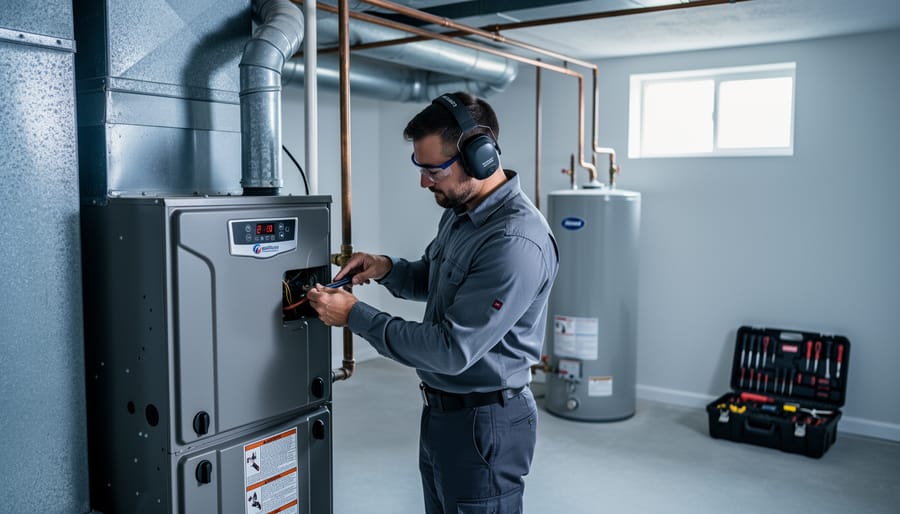Discover the perfect Weber Q grill for your outdoor cooking needs with our comprehensive side-by-side comparison of the most popular models. From the compact Q1000 series ideal for balconies to the family-sized Q3200, each Weber Q model offers distinct advantages for different cooking styles and spaces. Seasoned grillers and newcomers alike appreciate these portable powerhouses for their exceptional heat distribution, sturdy construction, and versatile cooking capabilities.
Our hands-on testing reveals crucial differences in cooking area, BTU output, and convenience features that directly impact your grilling experience. The Q1000 series excels in portability and efficiency for small gatherings, while the Q2000 series strikes an ideal balance between size and performance. For those seeking premium features and larger cooking surfaces, the Q3000 series delivers restaurant-quality results in a still-manageable footprint.
Whether you’re looking to grill perfect steaks on your patio, pack a portable unit for camping, or upgrade your current setup, understanding these key differences ensures you’ll select the Weber Q that perfectly matches your lifestyle and cooking ambitions. Let’s explore how each model stacks up in terms of performance, value, and practical everyday use.
Weber Q1000 vs Q2000: Size and Performance Breakdown
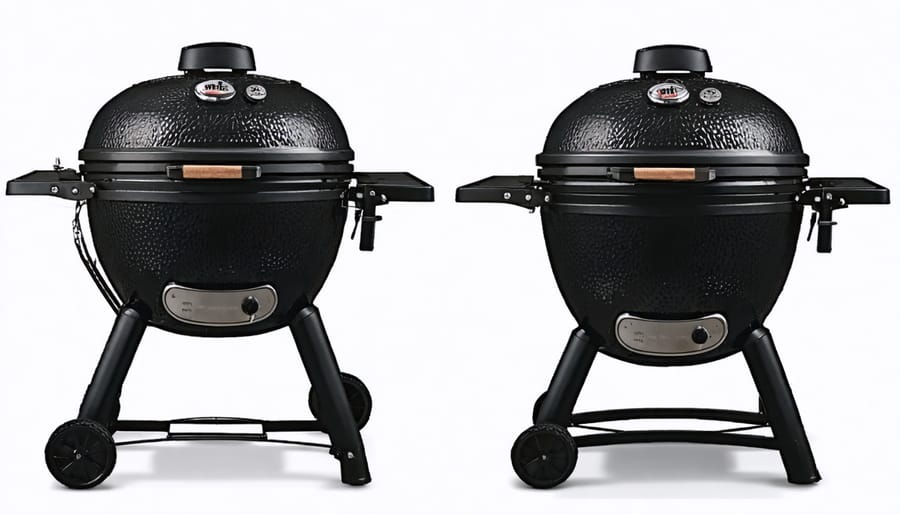
Cooking Surface and Capacity
When comparing Weber Q grills, the cooking surface and capacity differences play a crucial role in determining which model best suits your needs. The Q1000 series features a compact cooking area of 189 square inches, perfect for couples or small families. This space comfortably fits about 6-8 hamburger patties or 4-6 medium-sized steaks.
Moving up to the Q2000 series, you’ll find a more generous 280 square inches of cooking space, which can handle food for 4-6 people. This increased capacity allows you to grill up to 12 hamburgers simultaneously or manage a combination of proteins and vegetables for a complete meal.
The Q3000 series offers the most substantial grilling area at 393 square inches, ideal for larger gatherings or family barbecues. With this size, you can easily cook up to 18 burger patties at once or manage multiple food items with different cooking temperatures across the surface.
Each model features Weber’s signature porcelain-enameled cast-iron cooking grates, which provide excellent heat retention and those coveted sear marks. The grates are also designed with optimal spacing to prevent smaller food items from falling through while ensuring proper airflow for even cooking.
Remember that while bigger isn’t always better, choosing the right size depends on your typical gathering size and cooking style. Consider how much food you usually prepare and the available space in your outdoor area when selecting your ideal Weber Q grill.
Heat Output and Temperature Control
The Weber Q series offers varying levels of heat output across its models, with BTU ratings that align well with each grill’s cooking surface. The Q1000 series delivers 8,500 BTUs, which proves sufficient for its compact size and typical cooking needs. Moving up to the Q2000 series, you’ll find an increased output of 12,000 BTUs, providing more powerful heating capabilities for larger cooking sessions.
Temperature control is remarkably consistent across all Weber Q models, thanks to their signature infinite control burner valve. This feature allows for precise adjustments from low to high heat, making it easy to maintain your desired cooking temperature. Each model includes a built-in thermometer in the lid, helping you monitor cooking temperatures without lifting the cover and losing precious heat.
The Q3000 series steps up the game with dual burners totaling 21,700 BTUs, offering superior temperature control and the ability to create distinct cooking zones. This two-burner system allows for both direct and indirect grilling methods, providing more versatility in your cooking approach.
All models feature Weber’s efficient heat distribution system, utilizing porcelain-enameled cast iron cooking grates that retain and distribute heat evenly. The aluminum heat retention liners in the lid and body help maintain consistent temperatures, even in cooler weather conditions. This thoughtful design ensures food cooks uniformly, regardless of which Q series model you choose.
Moving Up: Q2200 and Q3200 Features
Built-in Thermometer and Lighting
When comparing Weber Q grills, the built-in features can make a significant difference in your grilling experience. Higher-end models like the Q2200 come equipped with a built-in lid thermometer, offering precise temperature monitoring without additional accessories. If you’re curious about the specific Q2000 and Q2200 differences, the thermometer is one of the standout features that sets them apart.
The lid thermometer proves invaluable when preparing temperature-sensitive foods like poultry or roasts. For tech-savvy grillers, Weber’s smart grilling technology, including Weber iGrill temperature monitoring systems, can be integrated with select models for even more precise control.
Lighting features also vary across the Weber Q series. Most models include convenient push-button electronic ignition systems, ensuring reliable starts every time. The Q2200 and higher-end models feature ergonomically designed control knobs with infinite control settings, allowing for precise temperature adjustments.
Some models also incorporate LED lighting solutions, perfect for evening grilling sessions. These lights are strategically positioned to illuminate the cooking surface without causing glare or shadows, ensuring you can monitor your food properly even after sunset.
The combination of accurate temperature monitoring and reliable lighting systems makes Weber Q grills particularly user-friendly, especially for those new to grilling or those who prefer precise control over their cooking environment. These built-in features not only enhance convenience but also contribute to more consistent cooking results across all your grilling adventures.
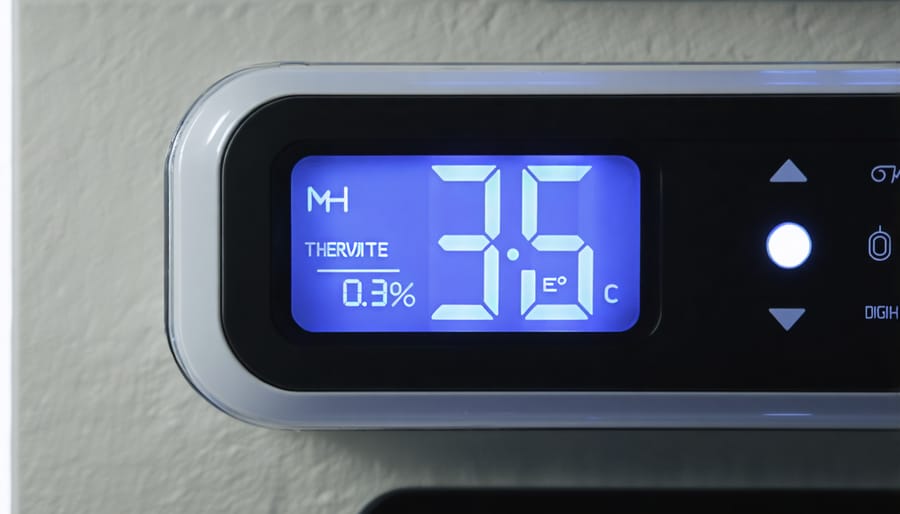
Stand Options and Mobility
When it comes to mobility and stand options, Weber offers versatile solutions across their Q grill lineup. The basic models come with built-in lid handles and sturdy legs for tabletop use, but it’s the available cart systems that truly enhance their functionality.
The portable cart stand, compatible with most Q series models, features all-weather wheels and a convenient fold-up design that’s perfect for storage or transport. For those seeking more stability, the stationary cart provides a fixed base with tool hooks and a bottom wire rack for additional storage space.
Q1000 and Q1200 models are designed with portability in mind, weighing around 27 pounds without the cart. Their compact size makes them ideal for camping, tailgating, or small patio spaces. The Q2000 and Q2200, while slightly heavier at approximately 42 pounds, still maintain reasonable portability when needed.
The premium cart option, available for Q2000 series models, includes features like an ergonomic handle, larger wheels for improved maneuverability, and a front-loading design that makes propane tank changes easier. Two side tables provide valuable prep space and fold down when not in use, creating a smaller footprint for storage.
For those who frequently move their grill, Weber’s newer cart designs incorporate a push-button folding mechanism that allows for quick setup and breakdown without tools. The built-in lid holders on all models ensure safe operation when checking or flipping food, regardless of whether you’re using a cart or tabletop setup.
All stand options are constructed with weather-resistant materials, ensuring longevity and maintaining the grill’s mobility features through various seasons and conditions.
Real-World Performance Testing
Direct Heat Grilling Results
When it comes to basic grilling performance, each Weber Q model shows distinct characteristics worth noting. The Q1200 excels at cooking for smaller groups, maintaining consistent temperatures across its cooking surface and delivering excellent searing on burgers and steaks. Its single burner provides enough heat for most direct grilling tasks, though you may need to work in batches when cooking for more than 4 people.
The Q2200 steps up the game with its larger cooking area and increased BTU output, making it notably more efficient at handling bigger loads. During testing, it achieved better overall heat distribution and showed superior performance when searing multiple steaks simultaneously. The extra grilling space proves particularly valuable when cooking different foods that require similar temperatures.
Moving up to the Q3200, the dual-burner system creates more versatile heat zones, allowing you to sear on high heat while maintaining a lower temperature area for more delicate items. This model demonstrated the most impressive searing capabilities of the series, producing restaurant-quality grill marks and maintaining steady temperatures even with the lid opened frequently.
All models showed excellent heat retention thanks to their cast aluminum construction, though the Q3200 recovered temperatures most quickly after opening the lid. For basic grilling tasks like burgers, chicken breasts, and vegetables, each model performs admirably, with the main differences lying in capacity and cooking time efficiency.
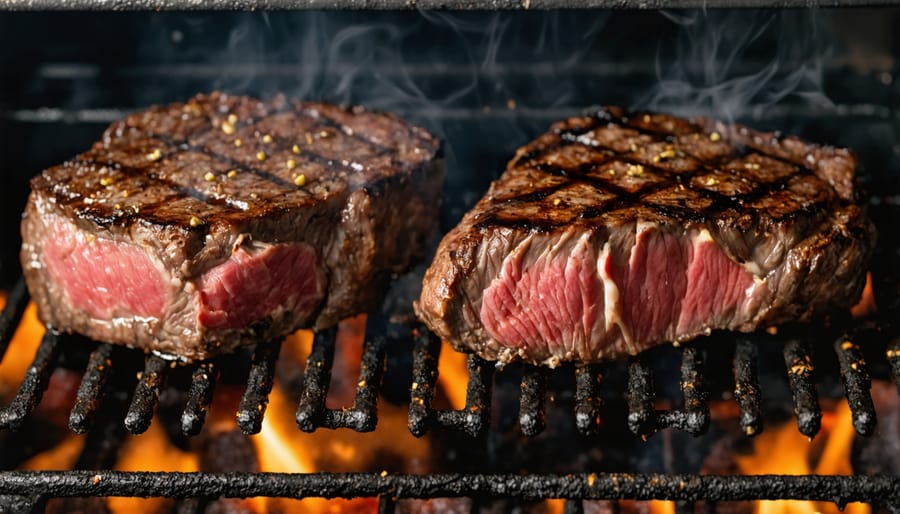
Space Management and Convenience
When it comes to maximizing limited outdoor space, each Weber Q grill model offers distinct advantages. The compact Weber Q1000 series proves ideal for small balconies and patios, with its modest 189-square-inch cooking surface fitting comfortably in tight spaces. Its portable design allows for easy storage when not in use, making it perfect for apartment dwellers.
Moving up to the Q2000 series, you’ll find a larger 280-square-inch cooking surface while maintaining a relatively compact footprint. The fold-down side tables offer valuable prep space without permanently consuming precious real estate. These tables can be collapsed when storing the grill, providing excellent space efficiency for those who need more cooking capacity but still face space constraints.
The Q3000 series, while offering the largest cooking area at 393 square inches, incorporates clever design elements to maximize space utility. Its built-in cart design with wheels allows for easy mobility, letting you reclaim your outdoor space when grilling is done. The permanent side tables might seem like a space compromise, but they eliminate the need for additional prep surfaces or tables.
For those truly limited on space, all Weber Q models can be adapted for tabletop use, and most can be mounted on optional portable cart systems that can be easily wheeled away for storage. This versatility ensures that regardless of your spatial constraints, there’s a Weber Q configuration that can work for your setup.
Value and Recommendations
Best Model for Different Scenarios
Choosing the right Weber Q grill depends largely on your specific needs and lifestyle. For apartment dwellers or those with limited outdoor space, the Weber Q1000 is the ideal choice. Its compact footprint and portable design make it perfect for small balconies while still offering enough cooking space for 2-3 people.
If you frequently host backyard gatherings for family and friends, the Weber Q2200 strikes an excellent balance between portability and capacity. Its larger cooking surface and enhanced heat control make it suitable for cooking multiple dishes simultaneously, perfect for serving 4-6 people comfortably.
For tailgating enthusiasts and camping adventures, the Weber Q1200 stands out as the top choice. Its built-in lid thermometer, ergonomic side handles, and sturdy construction make it ideal for transport and outdoor cooking. The electronic ignition ensures reliable starts even in windy conditions.
The Weber Q3200 is the best option for those seeking a permanent patio installation. With its built-in cart, larger cooking area, and dual burner system, it functions more like a full-sized grill while maintaining the beloved Q series features. It’s perfect for year-round grilling and can easily handle cooking for 6-8 people.
For those prioritizing versatility, the Q2000 offers the best value. It’s powerful enough for everyday use yet portable enough for occasional travel, making it an excellent all-rounder for various grilling scenarios.
Price vs. Features Analysis
When comparing Weber Q grills, the relationship between price and features reveals interesting value propositions across the lineup. Entry-level models like the Q1000 offer essential grilling capabilities at a more accessible price point, making them ideal for occasional grillers or those with limited space. As you move up to mid-range options, you’ll find enhanced features that justify the incremental cost increase.
The premium Q series features found in models like the Q2200 and Q3200 command higher prices but deliver noticeable improvements in cooking performance and convenience. These include larger cooking surfaces, built-in thermometers, and electronic ignition systems. While these upgrades add to the initial investment, they often prove worthwhile for frequent grillers who value precision and reliability.
Consider your long-term grilling needs when evaluating prices. A slightly higher upfront cost for a more capable model can provide better value over time, especially if you’ll be using the grill regularly. The durability of Weber Q grills also factors into the value equation – their robust construction and warranty coverage help justify the premium pricing compared to budget alternatives.
For most homeowners, the sweet spot lies in the middle of the range, where you get essential features without paying for extras you may never use. However, if you’re an enthusiast who appreciates fine temperature control and superior cooking versatility, investing in a higher-end Q model could be well worth the additional expense.
When comparing Weber Q grills, the key differences come down to size, cooking capacity, and specific features. The Q1000 series offers excellent portability and efficiency for small gatherings, while the Q2000 series provides more cooking space and enhanced temperature control for larger groups. If you’re primarily cooking for 2-4 people and value portability, the Q1000 series is your best bet. For families of 4-6 or those who frequently entertain, the Q2000 series delivers the extra capacity you need. Both lines maintain Weber’s signature quality and performance, featuring durable construction and reliable ignition systems. Consider your typical cooking needs, available storage space, and whether you’ll be moving the grill frequently when making your final decision. Whichever model you choose, you’ll enjoy the convenience and reliability that’s made the Weber Q series a favorite among grill enthusiasts.

